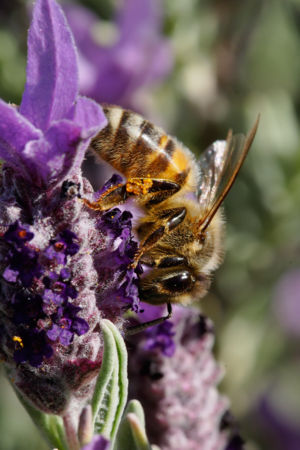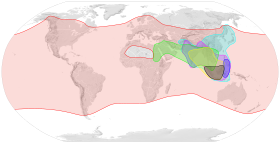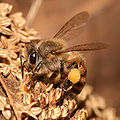Khác biệt giữa bản sửa đổi của “Ong mật”
n →Liên kết ngoài: clean up, replaced: {{Apidae-stub}} → {{Apinae-stub}} using AWB |
|||
| Dòng 40: | Dòng 40: | ||
==Nguồn gốc== |
==Nguồn gốc== |
||
Có ý kiến cho rằng, loài ong mật có tổ tiên ở châu Á, trái ngược với quan điểm trước đây cho rằng chúng xuất phát từ châu Phi. Với phương pháp phân tích gene để giải mã lịch sử tiến hóa của loài ong mật, loài ong mật (Apis mellifera) có dòng dõi cổ xưa là loài ong sống trong các hố hốc. Những con ong cổ đại này xuất thân từ châu Á khoảng 300.000 năm trước đây sau đó lan rộng sang châu Âu và châu Phi. Cây tiến hóa xây dựng từ trình tự các bộ gene không ủng hộ quan điểm cho rằng ong mật có nguồn gốc từ châu Phi. Số lượng ong mật đã và đang chịu ảnh hưởng của hiện tượng biến đổi khí hậu. Ong mật là loài côn trùng thụ phấn hàng đầu, ít nhất một phần ba số lượng thực phẩm con người sử dụng hàng ngày là sản phẩm cây trồng được thụ phấn bởi loài ong.<ref>[http://vnexpress.net/tin-tuc/khoa-hoc/ong-mat-co-nguon-goc-tu-chau-a-3036974.html Ong mật có nguồn gốc từ châu Á]</ref> |
Có ý kiến cho rằng, loài ong mật có tổ tiên ở châu Á, trái ngược với quan điểm trước đây cho rằng chúng xuất phát từ châu Phi. Với phương pháp phân tích gene để giải mã lịch sử tiến hóa của loài ong mật, loài ong mật (Apis mellifera) có dòng dõi cổ xưa là loài ong sống trong các hố hốc. Những con ong cổ đại này xuất thân từ châu Á khoảng 300.000 năm trước đây sau đó lan rộng sang châu Âu và châu Phi. Cây tiến hóa xây dựng từ trình tự các bộ gene không ủng hộ quan điểm cho rằng ong mật có nguồn gốc từ châu Phi. Số lượng ong mật đã và đang chịu ảnh hưởng của hiện tượng biến đổi khí hậu. Ong mật là loài côn trùng thụ phấn hàng đầu, ít nhất một phần ba số lượng thực phẩm con người sử dụng hàng ngày là sản phẩm cây trồng được thụ phấn bởi loài ong.<ref>[http://vnexpress.net/tin-tuc/khoa-hoc/ong-mat-co-nguon-goc-tu-chau-a-3036974.html Ong mật có nguồn gốc từ châu Á]</ref> |
||
==Bee products== |
|||
{{refimprove section|date=August 2016}} |
|||
===Honey=== |
|||
{{Main article|Honey}} |
|||
Honey is the complex substance made when bees ingest nectar, process it, and store the substance into honey combs. All living species of ''Apis'' have had their honey gathered by indigenous peoples for consumption. ''A. mellifera'' and ''A. cerana'' are the only species that have had their honey harvested for commercial purposes. Honey is sometimes also gathered by humans from the nests of various stingless bees. |
|||
In 1911, a bee culturist estimated a [[quart]] (about a [[litre]]) of honey represented bees flying over an estimated 48,000 miles to gather the nectar needed to produce the honey.<ref>[https://books.google.com/books?id=-t0DAAAAMBAJ&pg=PA889&dq=Popular+Mechanics+Science+installing+linoleum&hl=en&sa=X&ei=y4zsT9OSGMriqAGU1PW8BQ&sqi=2&ved=0CDYQ6AEwAA#v=onepage&q&f=true "A Quart of Honey Means 48,000 miles of flight"] ''Popular Mechanics'', December 1911, p. 889.</ref> |
|||
===Nectar=== |
|||
{{Main article|Nectar}} |
|||
Nectar, a liquid high in sucrose, is produced in plant glands known as nectaries. It is an important energy resource for honey bees and plays a significant role in foraging economics and evolutionary differentiation between different subspecies. It was proposed through an experiment conducted with the African honey bee, [[African bee|''A. m. scutellata'']], that nectar temperature impacts the foraging decisions of honey bees.<ref name="Fewell and Bertram, 2002">{{cite journal|last=Fewell|first=Jennifer H.|author2=Susan M. Bertram|title=Evidence for genetic variation in worker task performance by African and European honeybees|journal=Behavioral Ecology and Sociobiology|year=2002|volume=52|pages=318–25|doi=10.1007/s00265-002-0501-3}}</ref> |
|||
===Beeswax=== |
|||
{{Main article|Beeswax}} |
|||
Worker bees of a certain age secrete [[beeswax]] from a series of glands on their abdomens. They use the wax to form the walls and caps of the comb. As with honey, beeswax is gathered by humans for various purposes. |
|||
===Pollen=== |
|||
{{Main article|Bee pollen}} |
|||
Bees collect [[pollen]] in their [[pollen basket]]s and carry it back to the hive. In the hive, pollen is used as a [[protein]] source necessary during brood-rearing. In certain environments, excess pollen can be collected from the hives of ''A. mellifera'' and ''A. cerana''. It is often eaten as a health supplement. It also has been used with moderate success as a source of pollen for [[Hand-pollination|hand pollination]] However, pollen collected by bees and harvested for pollination must be used within a few hours because it loses its potency rapidly, possibly because of the effects of enzymes or other chemicals from the bees.{{citation needed|date=October 2014}} |
|||
===Bee bread=== |
|||
Worker bees combine pollen, honey and glandular secretions and allow it to ferment in the comb to make bee bread. The fermentation process releases additional nutrients from the pollen and can produce antibiotics and fatty acids which inhibit spoilage. Bee bread is eaten by [[Worker bee#Nurse bee (days 3–11)|nurse bees]] (younger workers) who then produce the protein-rich royal jelly needed by the queen and developing larvae in their hypopharyngeal glands. |
|||
===Propolis=== |
|||
{{Main article|Propolis}} |
|||
[[Propolis]], or bee glue, is created by bees from resins, balsams, and [[Sap (plant)|tree sap]]s. Some species use propolis to seal cracks in the hive. [[Apis florea|Dwarf honey bees]] use propolis to defend against ants by coating the branch, from which their nest is suspended, to create a sticky moat. Propolis is consumed by humans as a health supplement in various ways and also used in some cosmetics. |
|||
== Hình ảnh == |
== Hình ảnh == |
||
Phiên bản lúc 02:08, ngày 26 tháng 5 năm 2017
| Ong mật | |
|---|---|
| Thời điểm hóa thạch: Oligocene–Recent | |
 Một con ong mật | |
| Phân loại khoa học | |
| Giới (regnum) | Animalia |
| Ngành (phylum) | Arthropoda |
| Lớp (class) | Insecta |
| Bộ (ordo) | Hymenoptera |
| Họ (familia) | Apidae |
| Phân họ (subfamilia) | Apinae |
| Tông (tribus) | Apini Latreille, 1802 |
| Chi (genus) | Apis Linnaeus, 1758 |
 | |
| Các loài | |
Danh sách
| |
Ong mật hay chi ong mật (danh pháp khoa học: Apis) họ Ong mật (Apidae) trong bộ Cánh màng (Hymenoptera) bao gồm những loài ong có đời sống xã hội và bản năng sản xuất mật ong.[1] Con ong cho mật thuộc giống Apis (Apis mellifera, Apis cerana Fabr, Apis ligustica, Apis sinensis,...) hoặc các giống Maligona, Trigona,... đều thuộc họ ong (Apidae). Ong mật còn gọi là ong khoái, to con hơn, đốt đau, tổ thường ở các hốc cây, hốc đá, có thể bắt về nuôi được để lấy mật.
Đặc điểm
Trong một đàn có ong chúa, ong đực và ong thợ. Ong chúa có thân dài 20 – 25 mm. Cánh ngắn, kim châm ngắn. Ong đực: thân dài 15 – 17 mm. Không có ngòi châm, cánh lớn. Ong đực chỉ có một tác dụng là giao phối với chúa tơ. Ong thợ: là những con ong cái mà bộ phận sinh dục bị thoái hoá, không có khả năng thụ tinh. Ong thợ thực hiện tất cả công việc của đàn ong: bảo vệ tổ, sản sinh sữa chúa để nuôi ấu trùng, hút mật hoa luyện thành mật ong.
Trong xã hội ong mật, một ít ấu trùng được chọn làm ong chúa và đa số còn lại làm ong thợ.[2] Đối với ong mật, các enzym trong ruột của ong mật có khả năng hóa giải chất độc của loại thuốc trừ sâu thường được sử dụng để diệt ve trong tổ ong mật. Ong mật có lông trên mắt để chúng thu nhặt phấn hoa. Ong có 5 mắt - 3 mắt nhỏ trên đỉnh đầu và 2 mắt to ở phía trước. Một con ong cần phải tìm 4.000 bông hoa để tạo nên đủ một thìa mật ong
Về thiên địch, ngoài mối đe dọa từ vi rút (là nguyên nhân chính dẫn tới sự suy giảm của loài ong mật[3]) và nấm độc, ong mật Bắc Mỹ còn gặp bị ruồi ký sinh biến thành xác chết biết bay đó là ruồi cái Apocephalus borealis tiêm trứng vào bụng nạn nhân. Ấu trùng ruồi sau khi ăn sạch phần cơ quan ở vùng ngực của ong sẽ đục khoét cơ thể sinh vật này và chui ra ngoài.[4]
Nguồn gốc
Có ý kiến cho rằng, loài ong mật có tổ tiên ở châu Á, trái ngược với quan điểm trước đây cho rằng chúng xuất phát từ châu Phi. Với phương pháp phân tích gene để giải mã lịch sử tiến hóa của loài ong mật, loài ong mật (Apis mellifera) có dòng dõi cổ xưa là loài ong sống trong các hố hốc. Những con ong cổ đại này xuất thân từ châu Á khoảng 300.000 năm trước đây sau đó lan rộng sang châu Âu và châu Phi. Cây tiến hóa xây dựng từ trình tự các bộ gene không ủng hộ quan điểm cho rằng ong mật có nguồn gốc từ châu Phi. Số lượng ong mật đã và đang chịu ảnh hưởng của hiện tượng biến đổi khí hậu. Ong mật là loài côn trùng thụ phấn hàng đầu, ít nhất một phần ba số lượng thực phẩm con người sử dụng hàng ngày là sản phẩm cây trồng được thụ phấn bởi loài ong.[5]
Bee products
Honey
Honey is the complex substance made when bees ingest nectar, process it, and store the substance into honey combs. All living species of Apis have had their honey gathered by indigenous peoples for consumption. A. mellifera and A. cerana are the only species that have had their honey harvested for commercial purposes. Honey is sometimes also gathered by humans from the nests of various stingless bees.
In 1911, a bee culturist estimated a quart (about a litre) of honey represented bees flying over an estimated 48,000 miles to gather the nectar needed to produce the honey.[6]
Nectar
Nectar, a liquid high in sucrose, is produced in plant glands known as nectaries. It is an important energy resource for honey bees and plays a significant role in foraging economics and evolutionary differentiation between different subspecies. It was proposed through an experiment conducted with the African honey bee, A. m. scutellata, that nectar temperature impacts the foraging decisions of honey bees.[7]
Beeswax
Worker bees of a certain age secrete beeswax from a series of glands on their abdomens. They use the wax to form the walls and caps of the comb. As with honey, beeswax is gathered by humans for various purposes.
Pollen
Bees collect pollen in their pollen baskets and carry it back to the hive. In the hive, pollen is used as a protein source necessary during brood-rearing. In certain environments, excess pollen can be collected from the hives of A. mellifera and A. cerana. It is often eaten as a health supplement. It also has been used with moderate success as a source of pollen for hand pollination However, pollen collected by bees and harvested for pollination must be used within a few hours because it loses its potency rapidly, possibly because of the effects of enzymes or other chemicals from the bees.[cần dẫn nguồn]
Bee bread
Worker bees combine pollen, honey and glandular secretions and allow it to ferment in the comb to make bee bread. The fermentation process releases additional nutrients from the pollen and can produce antibiotics and fatty acids which inhibit spoilage. Bee bread is eaten by nurse bees (younger workers) who then produce the protein-rich royal jelly needed by the queen and developing larvae in their hypopharyngeal glands.
Propolis
Propolis, or bee glue, is created by bees from resins, balsams, and tree saps. Some species use propolis to seal cracks in the hive. Dwarf honey bees use propolis to defend against ants by coating the branch, from which their nest is suspended, to create a sticky moat. Propolis is consumed by humans as a health supplement in various ways and also used in some cosmetics.
Hình ảnh
Chú thích
- ^ Ong mật Apis tại Từ điển bách khoa Việt Nam
- ^ Đẳng cấp trong xã hội ong mật Khang Huy, báo Thanh Niên, 25/09/2011 17:59
- ^ Phát hiện virus thảm sát loài ong Nguyễn Hường 14:04 31/12/2010 (GMT+7) (Theo National Geographic)
- ^ Ruồi ký sinh biến ong thành thây ma Hạo Nhiên, báo Thanh Niên, 11/01/2012 00:20
- ^ Ong mật có nguồn gốc từ châu Á
- ^ "A Quart of Honey Means 48,000 miles of flight" Popular Mechanics, December 1911, p. 889.
- ^ Fewell, Jennifer H.; Susan M. Bertram (2002). “Evidence for genetic variation in worker task performance by African and European honeybees”. Behavioral Ecology and Sociobiology. 52: 318–25. doi:10.1007/s00265-002-0501-3.
Liên kết ngoài
| Wikispecies có thông tin sinh học về Ong mật |
| Wikimedia Commons có thêm hình ảnh và phương tiện truyền tải về Ong mật. |
- Ong mật tại Encyclopedia of Life
- Ong mật tại trang Trung tâm Thông tin Công nghệ sinh học quốc gia Hoa Kỳ (NCBI).
- Ong mật 154395 tại Hệ thống Thông tin Phân loại Tích hợp (ITIS).







